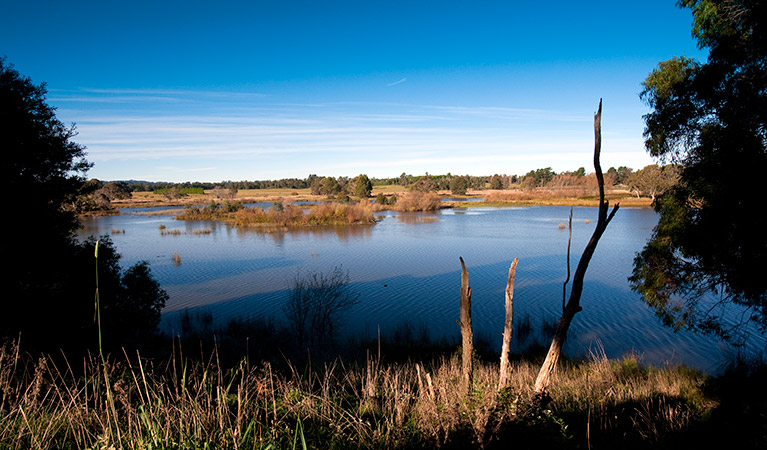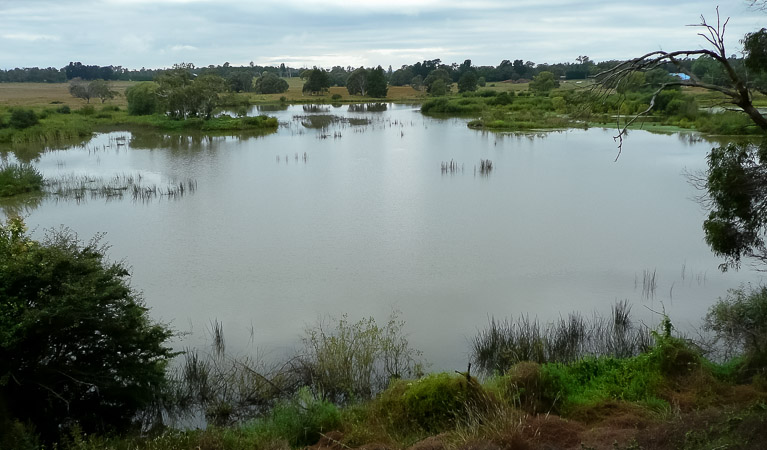Wingecarribee River walking track
Cecil Hoskins Nature Reserve
Learn more
Learn more about why this park is special
Wingecarribee River walking track is in Cecil Hoskins Nature Reserve. Here are just some of the reasons why this park is special:
Aboriginal culture

The reserve lies within the traditional land of the Bong Bong people. Cultural, linguistic and spiritual knowledge associated with this area continues to be passed on today. NPWS works in collaboration with local Aboriginal communities to protect this rich heritage.
The weir and the wherefore

Bong Bong weir was built in the 1920s to create a water supply for Moss Vale. The lagoon and swamp areas, which developed as a result of this weir, were declared a wildlife sanctuary in 1932. During the 1965-8 drought, Wingecarribee Council considered destroying the weir to allow water to be released for Berrima Cement Works, situated downstream. This proposal was so strongly opposed by the local community, however, that the idea was abandoned. The reserve supports stands of Paddys River box, native to the Moss Vale district and south of Jenolan, as well as snow gum banksia and a range of other native species. The lagoon itself is deep enough for large aquatic plants to thrive, such as tall spikerush, ribbonweed, yellow bladderwort and water milfoil. Other aquatic species include water snowflake, starwort, water primrose, river buttercup and nardoo.
- Weir View walking track Weir view walking track at Cecil Hoskins Nature Reserve is a short easy walk along the southern bank of the lagoon with scenic views and great birdwatching opportunities near Moss Vale.
- Wingecarribee River walking track Wingecarribee River walking track is a short easy walk from Cecil Hoskins picnic area, near Moss Vale. Enjoy scenic river views and birdwatching opportunities in Cecil Hoskins Nature Reserve.
Wetland creatures

Over 90 bird species inhabit the reserve and around one third of these, including pacific black ducks, black swans, dusky moorhens and grey teals, are waterbirds that are dependent on the lagoon. So if you're keen on bird watching, be sure to bring your binoculars along. Platypus and kangaroos also make their homes in and around the lagoon. The reserve also supports stands of Paddys River box, native to the Moss Vale district and south of Jenolan, as well as snow gum banksia and a range of other native species. The lagoon itself is deep enough for large aquatic plants to thrive, such as tall spikerush, ribbonweed, yellow bladderwort and water milfoil. Other aquatic species include water snowflake, starwort, water primrose, river buttercup and nardoo.
- Weir View walking track Weir view walking track at Cecil Hoskins Nature Reserve is a short easy walk along the southern bank of the lagoon with scenic views and great birdwatching opportunities near Moss Vale.
- Wingecarribee River walking track Wingecarribee River walking track is a short easy walk from Cecil Hoskins picnic area, near Moss Vale. Enjoy scenic river views and birdwatching opportunities in Cecil Hoskins Nature Reserve.
Who was Cecil Hoskins?

When the reserve was gazetted in 1975, it was named after Sir Cecil Hoskins. This man was a local resident for 40 years who not only had a keen interest in creating parks and gardens, but also contributed to the purchase of the land for the reserve.
